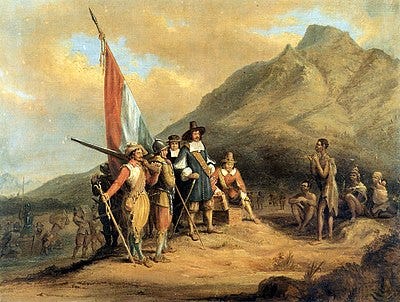Celebrating Jan van Riebeeck: A Journey Through South Africa's Roots
From Khoisan Encounters to Land Debates: Reflecting on a Pioneering Spirit
Greetings,
I hope this newsletter finds you well. Before we dive into today's topic, I'd like to apologize for the slight delay in sending out this issue. We intended to share this newsletter on April 6th, but due to unforeseen circumstances, we're a few days late. Thank you for your understanding and continued support.
In this edition of South Africa Insight, we'll be taking a look back at the remarkable accomplishments of Jan van Riebeeck, who arrived on the shores of South Africa on April 6th, 1652. While we may be a few days late, we believe it's essential to remember and appreciate the positive impact van Riebeeck had on the region.
Jan van Riebeeck played a crucial role in establishing the Cape of Good Hope as a refreshment station for ships traveling between Europe and Asia.
The settlement cultivated various fruits, vegetables, and herbs, which helped sustain both the European settlers and the ships passing through. The Cape of Good Hope eventually gained a reputation as a haven for agriculture. Van Riebeeck's leadership and vision laid the foundation for what would eventually become the vibrant city of Cape Town.
This classic image highlights a pivotal moment in South African history - the encounter between Jan van Riebeeck and the indigenous Khoisan people. It's important to note that the Khoisan, a nomadic Stone Age group, were the true indigenous inhabitants of the region at the time, and not the Bantu, Black, tribes that currently dominate South Africa's demographic landscape. The Bantu tribes arrived over a hundred years later during their migration from Central Africa.
Moving forward in history, the first documented encounter between European settlers and a Black Bantu tribe occurred in the 18th century. At that time, the Dutch Cape Colony was gradually expanding its territory, and as settlers moved further inland, they came into contact with Bantu-speaking communities. These initial meetings were marked by a mix of cooperation and conflict, as both sides sought to establish and negotiate territorial boundaries.
Turning our attention to contemporary South Africa:
A pressing question today is the issue of land in South Africa, where the ruling party, ANC, wants to expropriate white farmers' lands without compensation to redistribute to the black majority, under the pretext that the land was originally stolen due to what could be framed as the original sin of colonialism, from which all problems can be derived. The former president Jacob Zuma stated in a speech that van Riebeeck's arrival in Cape Town was the beginning of all South Africa's problems.
Some argue that South Africa belongs to the Black population simply because it is in Africa, a continent often perceived as 'Black.' However, the reality is that South Africa's indigenous people, the Khoisan, were nomads and the original inhabitants of the Cape region, followed by the Europeans and later, the Bantu tribes.
By comparing the length of time Europeans have been in South Africa to other countries, such as the United States, Australia, or New Zealand, we can gain a broader understanding of the historical context. Europeans first arrived in the Cape in 1652, while European settlement in Australia began in 1788, and in New Zealand in the early 19th century.
Reflecting on Jan van Riebeeck's arrival and his numerous accomplishments, we can appreciate the spirit of determination, innovation, and community that he embodied. These values accompanied the Boers on their arduous Voortrekker journey and continue to be an apt description of Riebeeck's Dutch descendants here in South Africa.
On a personal note, during my first visit to South Africa in 2008, I quickly became acquainted with the phrase "a Boer maak 'n plan." This saying, which translates to "a farmer makes a plan," reflects the resourcefulness and resilience of the Afrikaner people. It conveys their ability to adapt and find solutions to problems, no matter how challenging the situation may be. This spirit of ingenuity and tenacity is reminiscent of Jan van Riebeeck's determination when he transformed a seemingly barren land into something truly remarkable.
Once again, apologies for the delay in sending this newsletter. Your continued support and engagement are what make South Africa Insight possible. If you haven't already, make sure to subscribe to our newsletter for the latest updates, stories, and insights about South Africa.
Stay safe and take care,
Jonas Nilsson




